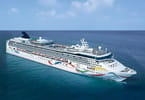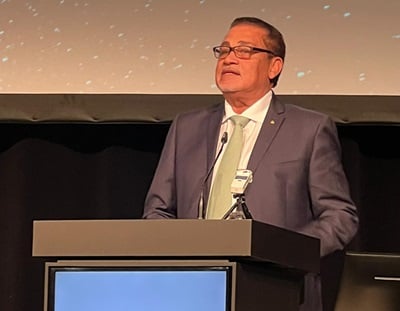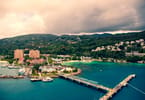SIROM OTVORENE OCI
2011 has been a year of dramatic changes and challenges. Economic crisis, regional revolution and reform, natural disasters, untimely losses of icons and institutions – many moments have simply been beyond fiction, beyond prediction, beyond expectation, and even beyond comprehension.
For the global travel and tourism industry, the year has shown once again, that not only is the industry remarkably resilient, so too are travelers. Thankfully. Major events prove time and again to inspire major curiosity and a desire to see it for oneself. Where crisis has occurred, travelers across the globe have become acutely aware of the impact their presence can have on destination recovery. Recovery of the economy, absolutely. But also, very importantly, recovery of the spirit of the social fabric. One leading example: Cairo’s Tahrir Square, the heart of Egypt’s swift and peacefully-concluded Arab Spring uprising, now stands tall as a leading tourist attraction. The world wants to see, and feel, where it happened.
With now seven billion people occupying the world, and the travel sector set to reach a milestone of one billion international arrivals in 2012, the scope of attraction of travel only grows. For some travelers, the quest is for a holiday that allows them to look at the world through rose-colored glasses: idyllic island getaways, untouched natural environments, quaint cultural communities in harmony with their place and their place in the universe. For others, the quest of travel is for a place that opens up new paths of discovery and opportunity for business or leisure. There are also those who seek out places that allow them to see the world in its raw geo-political state, looking issues and ideologies directly in the eye. And there are those who want to see how they can make a difference through their being there, helping places build a stronger future. Desires in travel are as numerous as the number of travelers. No destination need think they are left out.
For the destinations themselves, however, crisis can cause a natural reaction of shock, shame, and wanting to look away as fears of the loss of traveler interest and destination opportunity take over. Crisis at first appears to be a curse.
The Chinese proverb of the word “crisis” also meaning “opportunity,” an expression that became a heavily-used subtext of commentary as the global economic crisis began in the latter part of 2008, is a truism that cannot be overlooked.
As easy as it is for destinations to shut one’s eyes to what has occurred in a time of crisis, whether political, economic, natural or other, the real opportunity shines through when the crisis is looked at with eyes wide open.
AN INVALUABLE X-RAY
When crisis occurs, leaders of the tourism industry, both within the public and private sector, have thrown before them an immediate x-ray of the destination and all of its workings. Points of connection, coordination, and conflict become immediately visible. Like a human body put through an x-ray, immediately the weaker parts of the body appear – bones meant to provide strength that have become weakened, arteries meant to feed the body that have become blocked, foreign elements that have entered the body and are causing injury.
In the case of the tourism industry, this x-ray provides a clear view of not just where health needs to be restored in the workings of the destination, but how future wellness of the destination can be significantly enhanced.
For purposes of illustration, the MENA region – a collection of nations strongly dependent on tourism for social and economic advancement – is currently suffering from dramatic geopolitical changes, resulting in unparalleled declines in tourism industry activity.
The Arab Spring’s wave of revolution and reform in the Middle East and North Africa (MENA) has provided the world with a process of incredible and invaluable education around a part of the world often overlooked and under examined. At a most basic level, the MENA region’s uprising has taught the world regional geography. No longer is the Middle East seen as a mass of Arab states built on oil and lead by traditionally-dressed patriarchs. As the Arab Spring began to unfold, seeds of knowledge were planted across the region. As time passed and events unfolded, these seeds grew in knowledge, understanding, empathy, and appreciation.
Today, compared to just one year ago, the MENA region has evolved from being seen as a geo-block, to being understood with clear differences as nations, leaders, cultures, destinations, and fought-for futures.
While some nations continue to fight for freedom, others have successfully worked through their periods of change and taken their first steps on a new path for the future. Elections are underway. Still, recovery of their tourism sectors remains weak – slow, shaky and instable. Hope, however, remains strong. Reason being, for nations such as Tunisia, Morocco, Egypt and Jordan, the sector is seen, clearly as a critical part of the economy, and now, its ability to get back on its feet. As stated by Amr Badr, Managing Director of Abercrombie & Kent (A&K) in Egypt and the Middle East since 1999, “the Egyptian people believe that tourism is a life vest that is essential to our economic recovery.”
Events of the Arab Spring thrust nations experiencing uprisings into a downward spiral where tourist numbers are concerned. Understandably, tourists lost confidence in their ability to travel openly, safely, and peacefully through their MENA travel destinations of choice. For the travel industry, the weaker links of the tourism sector were immediately exposed.
As arrivals numbers evaporated, what became clearly visible were areas in which the destination, as a whole, as well as inter-dependent parts, must strengthen to rebuild the critical value and impact of the tourism sector.
As is the case with all destinations around the world that face crisis, be it political, natural, economic, or other, the central and essential “engineering” of the destination becomes exposed. Core competencies were tested, capabilities exposed. As are paradigms, and the need for paradigm shifts. One of the most important: that tourism stands alone.
Amr Badr of A&K continued: “Until now, it was unusual for the (tourism) industry to connect the political and social environment around us to our business. People in tourism did not usually think of geopolitical issues and saw the business as luxury, leisure, and separate from daily life. However, for people in the business of tourism, it is essential to connect regional, economic, and geopolitical issues to traveler itineraries.”
With billions being lost in the tourism economy during times of crisis, the role that tourism plays in economic growth and development of national economies is clear. Now more than ever the economic impact of the tourism industry is being revealed, vividly. Jobs, revenues, investment, and confidence lost hit not just the spirit of the destination, but the balance sheets. Whether Egypt, Jordan, Japan, Tunisia, Thailand, or any other tourism destination confronted with crisis, the message of “tourism matters!” could not be stronger.
GAINING STRENGTH THROUGH SEEING THE WEAKNESSES
Crisis in tourism destinations over the past year, and years, has afforded tourism leaders across the globe the opportunity to identify, in many cases immediately, where weaknesses exist in their destination and, therefore, where opportunities exist for future strengthening.
Crisis brings attention, it brings awareness, it brings opportunity. It also brings compassion, cooperation, unity, identity, and the calling forward of inner strength.
Reflecting on the past decade, Amr Badr is clear of how his perspective on tourism business leadership has changed. “When I flash back over the last 10 years, if I have learnt anything, it is to always project, prepare, plan. In our business, always, always, always look closely at domestic affairs, regional geopolitics, and connect it to your business in order to project, prepare, and plan,” he said.
With so many things changing, to effectively run a travel business, and destination, both business leaders and tourism officials in office need to think: “If something happens in ____, how does that impact my business/destination? How does that affect future growth for my business/destination?”
This approach applies to both the negative and positive preparedness to crisis. On the negative side of “what if,” the travel industry needs to ensure that systems and structures are in place to ensure traveler location, protection, communication, and, if required, evacuation. An immediate response plan needs to be created, in advance, to deal with different scenarios that may unfold on the ground.
At a governmental level, immediate support must be available to the operators for the industry, prioritizing traveler safety and destination information first and foremost.
For destinations observing neighboring nations in crisis, the negative “what if” can be as a result of a rub-off effect. As seen in Jordan and Morocco, while their domestic situations were far milder than the severe levels of crisis faced in neighboring nations such as Libya, Yemen, Tunisia, and, sadly, once again Egypt, still their proximity to trouble can have a negative impact on their tourism industry.
On the flipside, when things go wrong in one destination, there is a natural redistribution of business that can make things go right for another destination. Some destinations may, in fact, find that crisis nearby opens up opportunity. As stated earlier, the travel industry is resilient because travelers are resilient. For holiday makers headed to i.e. Luxor this past year, yet nervous about the risk of further political clashes, the desire to travel did not go away, it simply shifted in destination. The GCC region and Greece have enjoyed growth in their tourism arrivals as travelers activated their Plan B.
Whether positive or negative, the tourism sector as a whole needs to have quick answers to how to quickly mobilize critical destination systems and structures (i.e., airlines, airports, hotels, travel operators, foreign offices, etc.), to align the tourism industry and (re)activate the economic sector.
FOCUSING ON THE FUNDAMENTALS
While there are countless learnings that come out of crisis, the events of 2011 have exposed five main areas of opportunity for tourism sector insight, and, therefore, strengthening of destination engineering at both public and private sector levels, namely:
1. Destination Information and Education:
Crisis teaches geography. As newswires convey stories of crisis, details around the where teach audiences (and potential travelers) about the different parts of the nation – their locations, their geographic differences, their social and cultural make-ups, and often their attractions. This new knowledge should be built upon during- and post-crisis to enable ongoing understanding of the situation on the ground, its location vis-a-vis other parts of the destination, and when ready, its invitation to travelers to (re)visit.
2. Private Sector Cooperation:
When addressing crisis, strength of response is indeed in numbers, even if these numbers are natural competitors. As stated by Amr Badr: “When it comes to the private sector, our relationship moving forward should not be about competition, but about sharing, and bringing together the industry to apply pressure to ensure that crisis response is swift and singular. Peer pressure works, especially when government support and action is needed.”
3. Media Engagement:
The moment crisis breaks, the media is there, covering the story from all angles. This is exactly why the destination’s leaders need to be there alongside, available as a first-call source and resource. Proactive media engagement is critical to ensuring that the story is told correctly, consistently, holistically, and through the correct lead voices for the industry. This requires that leaders of the sector – both private and public sector – be united as one voice, with clarity of messages and messengers. A strong example of effective, proactive media cooperation is Kenya’s handling of crisis in Q3/4 in 2011 as al-Shabaab rebels crossed Kenya’s border with Somalia and took the lives of tourists at north coast resorts. The national Minister of Tourism, the Honorable Najib Balala, immediately stepped forward as the destination’s first point of contact and comment regarding the impact of the crisis on tourism, working directly and transparently with global, regional, and national media. Confusion of what is going on, where, why, and what is being done about it, creates panic, spreads damage, and can have a negative effect far beyond the crisis itself. Accuracy, unity, proactivity and transparency with the media can only work for the destination.
4. Travel Advisory Management
Travel advisories remain one of the most contentious issues when it comes to in-destination crisis. Central to the problem is travel advisories being rapidly applied by home nations of potential travelers with immense speed, limited geospecification, and even less follow-up to update and remove the alerts. Efforts are being made by global tourism entities such as the UNWTO to work with governments worldwide to ensure that travel advisories are:
– geo-specific,
– time-bound, and
– updated.
In addition to these efforts, leaders of both the business communities and government tourism authorities must work with the global community to ensure that travel advisories are carefully managed, and timeously removed, so as to not stunt destination recovery efforts.
5. Regional Government Cooperation
Finally, it is in the interest of regional tourism that individual destinations recover, and uplift, the region as a whole. Working together to re-stimulate tourism activity, regional alliances can play a significant part in, most importantly, rebuilding traveler confidence, which will in turn rebuild activity. Times of crisis naturally unlock a desire to cooperate, to break out of the paralyzing grip of devastating challenges to a nation. Human compassion transcends competition. Taking a regional approach to crisis in tourism with collective updates on recovery efforts, as the UNWTO has been championing in the MENA region for example, allows all nations to rise above conflict for a more stable, secure, and promising future for regional tourism.
Ultimately, it is visible, proactive leadership that inspires and guides us through crisis. As expressed by Amr Badr, reflecting on what it will take for MENA to recover as an equitable, sustainable tourism region: “We are like any other business. We need stability, we need security, we need hope.”
In these ever-changing, ever-challenging times, one thing is clear: as an industry, as the fastest growing economy, and as the most diplomatic force for global peace and understanding in the world, travel and tourism is what the world needs to move forward.
As a new year dawns, with nations taking on new shapes and futures, may our quest to cross borders continue to bring us closer together, in all the ways that matter.






















